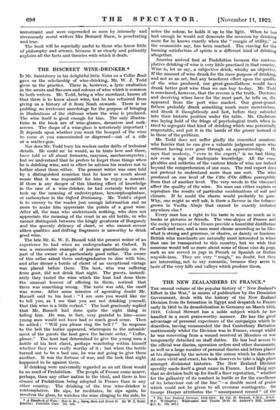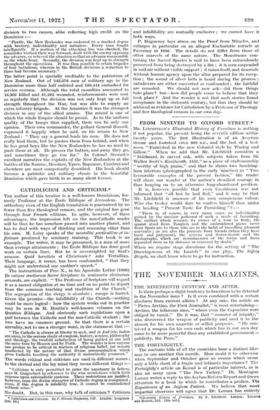THE NEW ZEALANDERS IN FRANCE.* THE second volume of the
popular history of " New Zealand's Effort in the War," in course of publication by- the Dominion Government, deals with the history of the New Zealand . Division from its formation in Egypt and despatch to France early in 1916 to its demobilization in Germany on March 25th, 1919. Colonel Stewart has a noble subject which he has handled in a most praiseworthy manner. He has the great advantage of personal experience of the campaigns which he describes, having commanded the 2nd Canterbury Battalion . continuously whilst the Division was in France, except whilst he was recovering from a wound received at Messines or was temporarily detached on staff duties. He has had access to the official war diaries, operation orders and other documents, as well as a large number of personal diaries and letters placed at his disposal by the actors in the scenes which he describes. At once vivid and exact, his book deserves to take a high place amongst divisional histories. The New Zealand Division speedily made itself a great name in France. Lord Haig says that no division built up for itself a finer reputation, " whether for the gallantry of its conduct in battle or for the excellence of its behaviour out of the line "—a double raced of praise which could not be given to all overseas contingents. Sir George Harper attributes the " unsurpassed record " of the • The New Zealand Division, 1916-1919. By Col. H. Stewart, C.H.G., M.C. Wellington : Whiteombe and Tombs (9-10 St. Andrew's Hill, London, X.C. 4). [Os. net.] division to two causes, alike reflecting high credit on the Dominion :—
" Meetly, the New Zealander was endowed to a marked degree with bravery, individuality and initiative. Every man fought intelligently. If a portion of the attacking line was checked, the remainder worked their way forward, dealt with the enemy opposing the advance, or relieved the situation so that an advance was possible on the whole front. Secondly, the division was kept up to strength throughout the operations. It was thus possible to retain brigades of four battalions, whereas in the British divisions a reduction to three had become necessary."
The latter point is specially creditable to the patriotism of New Zealand. Out of 243,376 men of military age in the Dominion more than half enlisted and 100,444 embarked for service oversell.. Although the total casualties amounted to 16,302 killed and 41,262 wounded, reinforcements were sent so regularly that the division was not only kept up at full strength throughout the War, but was able to supply an extra infantry brigade. At the Armistice it was the strongest division in any of the allied armies. The record is one of which the whole Empire should be proud. As to the uniform quality of the troops thus supplied, there can be only one opinion. Their own commander, the gallant General Russell, expressed it happily when he said, on his return to New
Zealand : " They say a general leads his men. He does not really lead them, but he pushes them from behind, and when he has good boys like the New Zealanders he has no need to push them at all. He presses the button, and away they go, and sometimes they go too far." In Colonel Stewart's
excellent narrative the exploits of the New Zealanders at the battles of the Somme, Messines, Ypres, Bapaume, Cambrai and elsewhere are most competently described. His book should become a patriotic and military classic in the beautiful Dominion which gave birth to so many silent heroes.



























































 Previous page
Previous page